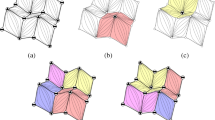Abstract
In this paper we give a practical and efficient output-sensitive algorithm for constructing the display of a polyhedral terrain. It runs in O((d+n)log2 n) time, where d is the size of the final display. While the asymptotic performance is the same as that of the previously best known algorithm, our implementation is simpler and more practical, because we try to take full advantage of the specific geometrical properties of the terrain. Our main data structure maintains an implicit representation of the convex hull of a set of points that can be dynamically updated in O(log2 n) time. It is especially simple and fast in our application since there are no rebalancing operations required in the tree.
Support was provided in part by National Science Foundation grant CCR-8906419.
Support was provided in part by a National Science Foundation Presidential Young Investigator Award CCR-9047466 with matching funds from IBM Corporation, by National Science Foundation grant CCR-9007851, by the U.S. Army Research Office under grant DAAL03-91-G-0035, and by the Office of Naval Research and the Defense Advanced Research Projects Agency under contract N00014-91-J-4052, ARPA order 8225.
Preview
Unable to display preview. Download preview PDF.
Similar content being viewed by others
References
S. Hart and M. Sharir, “Nonlinearity of Davenport-Schinzel Sequences and of a Generalized Path Compression Scheme,” Combinatorica 6(1986), 151–177.
D. T. Lee and F. P. Preparata, “Parallel Batch Planar Point Location on the CCC,” Information Processing Letters 33 (December 1989), 175–179.
M. H. Overmars and J. van Leeuwen, “Maintenance of Configurations in the Plane,” Journal of Computer and System Sciences 23(1981), 166–204.
F. P. Preparata and M. I. Shamos, Computational Geometry, Springer-Verlag, New York, 1985.
F. P. Preparata, J. S. Vitter, and M. Yvinec, “Computation of the Axial View of a Set of Isothetic Parallelepipeds,” ACM Transactions on Graphics 9 (July 1990), 278–300.
J. H. Reif and S. Sen, “An Efficient Output-Sensitive Hidden-Surface Removal Algorithm and its Parallelization,” 4th Annual ACM Symposium on Computational Geometry (June 1988), 193–200.
Author information
Authors and Affiliations
Editor information
Rights and permissions
Copyright information
© 1992 Springer-Verlag Berlin Heidelberg
About this paper
Cite this paper
Preparata, F.P., Vitter, J.S. (1992). A simplified technique for hidden-line elimination in terrains. In: Finkel, A., Jantzen, M. (eds) STACS 92. STACS 1992. Lecture Notes in Computer Science, vol 577. Springer, Berlin, Heidelberg. https://doi.org/10.1007/3-540-55210-3_179
Download citation
DOI: https://doi.org/10.1007/3-540-55210-3_179
Published:
Publisher Name: Springer, Berlin, Heidelberg
Print ISBN: 978-3-540-55210-9
Online ISBN: 978-3-540-46775-5
eBook Packages: Springer Book Archive




